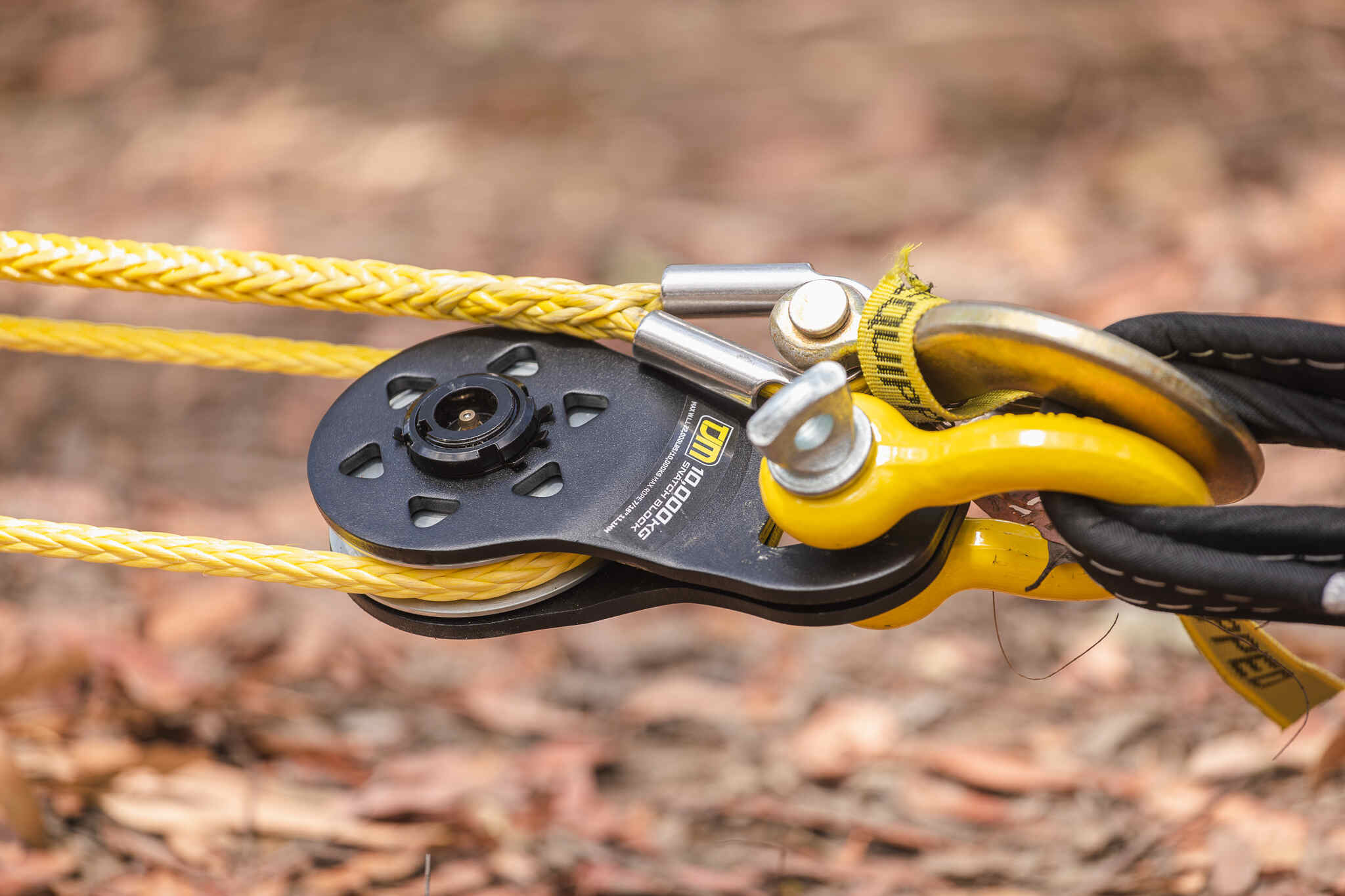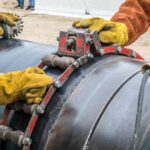A snatch block is a type of pulley block used in rigging and lifting systems to change the direction of a rope or cable, known as a “line.” It consists of one or more pulley wheels (sheaves) enclosed in a sturdy housing or frame. The primary purpose of a snatch block is to provide a secure anchoring point and redirect the line, allowing for more efficient application of force or a change in the direction of the pull.
Snatch blocks are typically composed of the following components:
- Housing or Frame: The outer casing that holds the sheaves and bearings in place. It is designed to be durable and withstand heavy loads, often made of materials like steel or aluminum alloy.
- Sheave(s): The grooved pulley wheel(s) around which the line runs. Sheaves are typically made of high-strength materials like steel or synthetic composites to resist wear and tear.
- Bearings: These allow the sheave(s) to rotate smoothly and with minimal friction, reducing energy loss and wear on the line.
- Attachment Point: A secure point on the housing or frame where the snatch block can be anchored or attached to a fixed structure or another rigging component.
The primary purpose of a snatch block is to change the direction of the pulling force applied to a line, enabling easier movement of heavy loads or access to hard-to-reach areas. By redirecting the line, snatch blocks can increase the mechanical advantage, allowing smaller forces to move or lift heavier objects. They are widely used in various industries, including construction, maritime, and entertainment rigging, as well as in rescue operations and outdoor activities like rock climbing and sailing.
Table of Contents
History and Evolution of Snatch Blocks
Snatch blocks have been used for centuries to change the direction of applied force and provide mechanical advantage in various lifting and rigging applications. Their origins can be traced back to ancient civilizations, where simple pulley systems were employed in the construction of monumental structures like the Egyptian pyramids.
In the early days, snatch blocks were rudimentary, consisting of a wooden or metal shell with a grooved wheel that allowed a rope or cable to run freely. These primitive designs were used in shipbuilding, construction, and other industries that required the lifting and moving of heavy loads.
As technology advanced, snatch blocks underwent significant improvements. The introduction of new materials, such as cast iron and steel, allowed for stronger and more durable designs. Additionally, the development of ball bearings and improved lubrication systems made snatch blocks more efficient and easier to operate.
During the Industrial Revolution, the demand for snatch blocks increased dramatically as heavy machinery and equipment became more prevalent in factories and construction sites. Manufacturers began producing snatch blocks in various sizes and configurations to meet the diverse needs of different industries.
In the modern era, snatch blocks have benefited from advancements in materials science and manufacturing processes. High-strength alloys, composite materials, and advanced coatings have made snatch blocks lighter, stronger, and more resistant to wear and corrosion. Computer-aided design (CAD) and computer numerical control (CNC) machining have also enabled the production of more precise and complex snatch block designs.
Today’s snatch blocks are not only stronger and more durable but also incorporate safety features like load-rating markings, swivel hooks, and overload protection mechanisms. Additionally, specialized snatch blocks have been developed for specific applications, such as those used in offshore oil and gas operations, where they must withstand harsh marine environments.
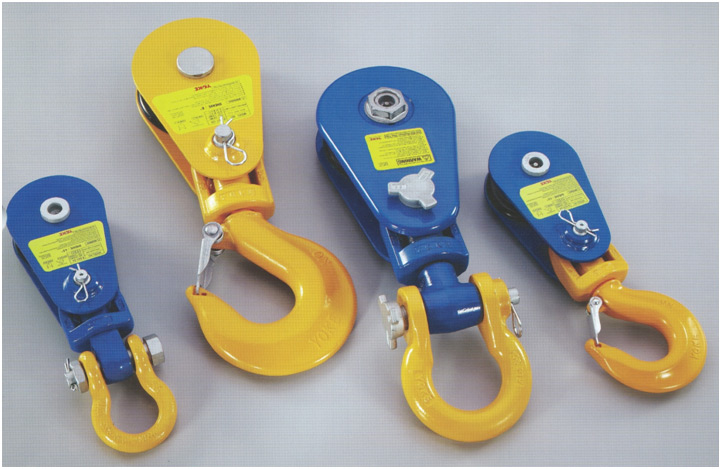
Types of Snatch Blocks
Snatch blocks come in various designs, materials, and sizes to accommodate different applications and load requirements. The primary types include:
Single Sheave Snatch Blocks: These are the simplest and most common snatch blocks, featuring a single pulley wheel or sheave enclosed in a robust housing. Single sheave blocks are lightweight, compact, and ideal for basic rigging operations involving lighter loads.
Double Sheave Snatch Blocks: Featuring two parallel pulley wheels or sheaves, double sheave snatch blocks offer increased load-bearing capacity and mechanical advantage. They are commonly used in construction, rigging, and material handling applications where heavier loads need to be lifted or redirected.
Triple Sheave Snatch Blocks: As the name suggests, these blocks have three parallel pulley wheels or sheaves, providing even greater load-bearing capacity and mechanical advantage. Triple sheave snatch blocks are often employed in heavy-duty industrial settings, such as shipyards, mining operations, and large-scale construction projects.
Wooden Snatch Blocks: Traditionally, snatch blocks were constructed from high-quality hardwoods like maple or ash. Wooden blocks are still used in certain applications, particularly in maritime settings, due to their durability and resistance to corrosion from saltwater.
Metal Snatch Blocks: Modern snatch blocks are predominantly made from various metals, including steel, aluminum, and alloys. Metal blocks offer superior strength, durability, and resistance to wear and tear, making them suitable for demanding industrial applications.
Synthetic Snatch Blocks: In recent years, snatch blocks made from high-performance synthetic materials, such as reinforced polymers and composites, have gained popularity. These blocks are lightweight, corrosion-resistant, and often used in outdoor and marine environments where weight and durability are crucial factors.
Snatch blocks are available in a wide range of sizes, from compact units suitable for light-duty tasks to massive blocks capable of handling loads weighing several tons. The size and capacity of a snatch block are determined by factors such as the sheave diameter, side plate thickness, and overall construction materials.
How Snatch Blocks Work
Snatch blocks are simple yet ingenious devices that employ the principles of mechanical advantage and force amplification. At their core, they are composed of one or more pulley wheels encased within a sturdy frame or housing, typically made of metal or high-strength composite materials.
The primary function of a snatch block is to change the direction of a pulling force, allowing the applied force to be redirected around obstacles or corners. This redirection is achieved by threading a rope or cable through the pulley wheel(s) within the snatch block, effectively creating a bend in the line.
Beyond their ability to alter the direction of a pulling force, snatch blocks also provide a mechanical advantage, which means they can amplify the applied force. This force amplification is made possible by the pulley system within the snatch block.
When a rope or cable is threaded through a single pulley, the mechanical advantage is 2:1, meaning that the load can be lifted with half the effort required if the rope were attached directly to the load. This principle can be further compounded by adding additional pulley wheels within the snatch block, creating complex pulley systems that can achieve even greater mechanical advantages.
The mechanical advantage provided by snatch blocks is determined by the number of rope or cable segments supporting the load. For instance, a snatch block with two pulley wheels and a single continuous rope will have a 4:1 mechanical advantage, allowing a load four times heavier than the applied force to be lifted.
Snatch blocks are designed to withstand immense loads and forces, making them essential components in various industries where heavy lifting, pulling, or tensioning is required. Their ability to change the direction of a pulling force and amplify the applied force makes them invaluable tools in rigging, construction, maritime operations, and many other applications.
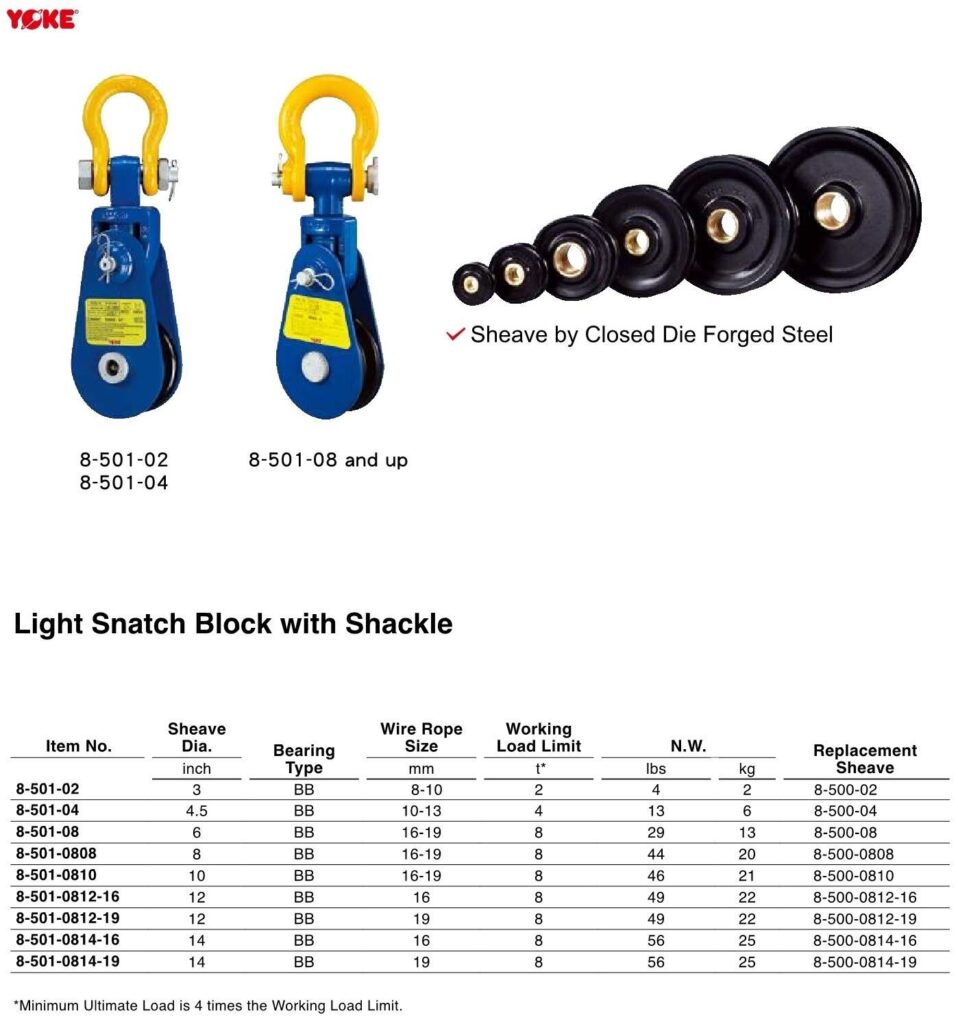
Applications of Snatch Blocks
Snatch blocks have a wide range of applications in various industries due to their ability to change the direction of a pulling force and increase the mechanical advantage. Here are some of the major applications of snatch blocks:
Rigging
In the rigging industry, snatch blocks are essential tools for lifting, positioning, and maneuvering heavy loads. They are commonly used in conjunction with wire ropes, chains, or other lifting devices to redirect the pulling force and provide a more efficient lifting system. Riggers often employ multiple snatch blocks in complex rigging setups to achieve the desired lifting angle or direction.
Sailing
Snatch blocks are indispensable in the sailing world, where they are used to control and redirect the lines (ropes) that control the sails and other components of the sailboat. They allow sailors to adjust the tension and direction of the lines, enabling them to trim the sails for optimal performance and maneuverability.
Construction
In the construction industry, snatch blocks are widely used for lifting and positioning heavy materials, such as steel beams, precast concrete components, and other building materials. They are often incorporated into crane setups, allowing for more efficient and safer lifting operations by redirecting the lifting force and reducing the strain on the crane’s components.
Heavy Lifting
Snatch blocks are essential tools in heavy lifting operations, where they are used in combination with chain hoists, wire rope pullers, or other lifting equipment. They help distribute the load more evenly, reduce the overall pulling force required, and enable lifting from various angles and directions.
Rescue Operations
In rescue operations, such as those performed by fire departments, search and rescue teams, and emergency services, snatch blocks play a crucial role. They are used to redirect and control the lines used for lifting or lowering people or equipment in challenging environments, such as high-rise buildings, confined spaces, or rugged terrain.
Snatch blocks are versatile tools that have become indispensable in many industries due to their ability to change the direction of a pulling force and increase the mechanical advantage. Their applications range from rigging and sailing to construction, heavy lifting, and rescue operations, making them an essential component in various setups and operations.
Choosing the Right Snatch Block
Selecting the appropriate snatch block for a specific application is crucial to ensure safe and efficient operations. Several factors must be considered when choosing a snatch block, including load capacity, size, material, and intended application.
Load Capacity: One of the most critical factors is the load capacity of the snatch block. It is essential to select a block that can safely handle the maximum anticipated load, including any potential dynamic forces or shock loads. Using a snatch block with insufficient load capacity can lead to failure, potentially causing property damage, injuries, or even fatalities.
Size: The size of the snatch block is another essential consideration. The block must be large enough to accommodate the rope or cable diameter without causing excessive wear or damage. Additionally, the size of the block should be compatible with the available space and clearance in the application area.
Material: Snatch blocks are available in various materials, including steel, aluminum, and synthetic materials like nylon or polyester. The choice of material depends on factors such as strength requirements, weight considerations, and environmental conditions. For instance, steel blocks are typically more robust but heavier, while aluminum or synthetic blocks are lightweight but may have lower load capacities.
Application: The intended application of the snatch block plays a significant role in the selection process. Different applications may require specific features or characteristics. For example, in marine applications, corrosion resistance and durability in harsh environments are crucial factors. In construction or rigging applications, ease of use and portability may be more important.
Safety Considerations: Safety should always be the top priority when choosing a snatch block. Look for blocks that comply with relevant safety standards and regulations. Additionally, consider features such as safety hooks, locking mechanisms, or load-bearing swivels that can enhance safety during operation.
It is essential to consult with professionals, refer to manufacturer specifications, and follow industry best practices when selecting a snatch block. Proper selection and use of snatch blocks can significantly contribute to safe and efficient operations across various industries.
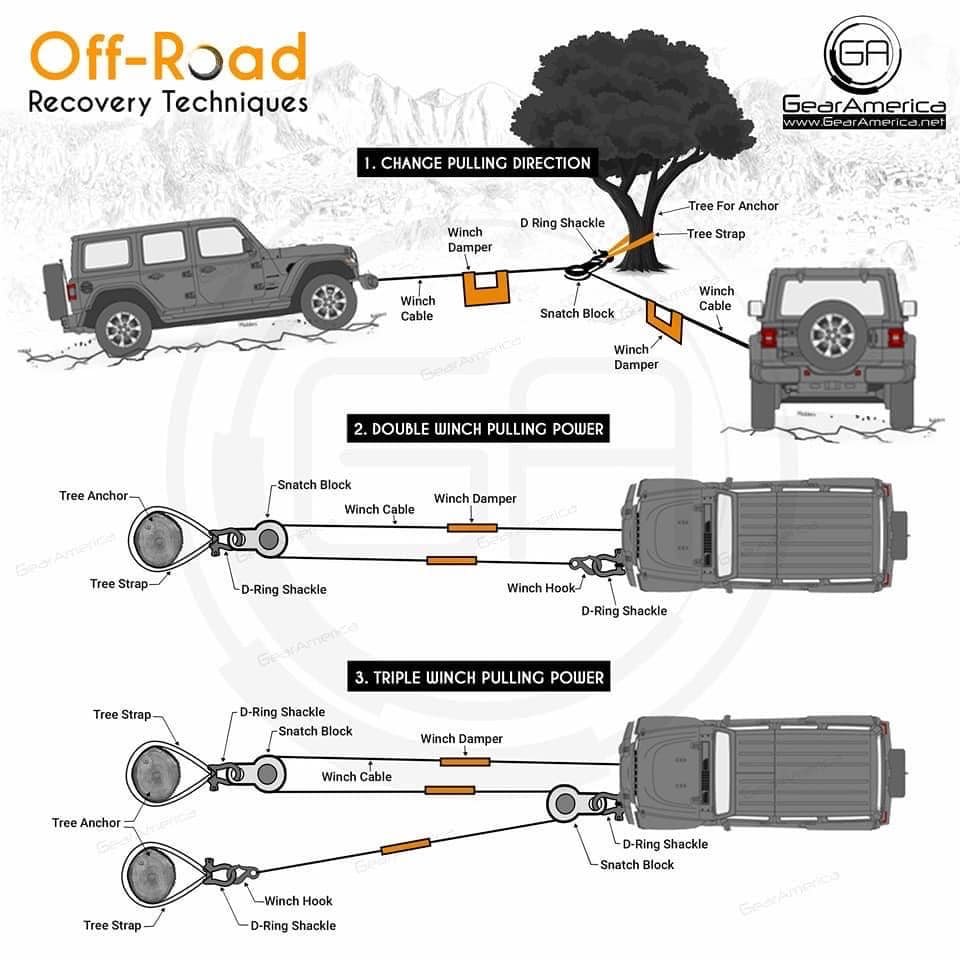
Installation and Use of Snatch Blocks
Proper installation and use of snatch blocks are crucial for safe and efficient operation. These blocks are designed to handle significant loads, making it essential to follow the manufacturer’s guidelines and industry best practices.
Installation Techniques
- Mounting: Snatch blocks can be mounted in various ways, including bolting them to a fixed structure, attaching them to a movable trolley, or suspending them from an overhead beam. Ensure the mounting surface or attachment point is sturdy enough to withstand the anticipated loads.
- Alignment: Proper alignment is essential to prevent side loading, which can damage the block or cause the line to jump off the sheave. Align the block correctly with the direction of the pulling force.
- Clearance: Ensure sufficient clearance around the block to allow for smooth line movement and prevent interference with other equipment or structures.
- Secure Connections: If using detachable side plates or other removable components, make sure they are securely fastened and properly torqued according to the manufacturer’s specifications.
Safe Operating Procedures
- Load Limits: Never exceed the specified working load limit (WLL) of the snatch block. Overloading can lead to catastrophic failure and potential injuries.
- Inspection: Before each use, inspect the block for any signs of wear, damage, or missing components. Replace or repair any defective parts immediately.
- Proper Rigging: Ensure the line is correctly reeved through the block and secured properly. Avoid twists, kinks, or excessive bending that can damage the line or block.
- Control and Communication: When working with a team, establish clear communication protocols and designate a signal person to coordinate the operation safely.
- Clearance and Pinch Points: Maintain a safe distance from the block and line during operation to avoid pinch points or being struck by moving components.
Maintenance
- Lubrication: Follow the manufacturer’s recommendations for lubricating the sheave bearings and other moving parts to ensure smooth operation and extend the block’s service life.
- Cleaning: Keep the block clean and free from dirt, debris, and contaminants that can accelerate wear or interfere with proper function.
- Storage: When not in use, store snatch blocks in a dry, protected area to prevent corrosion and damage.
- Periodic Inspections: Implement a scheduled inspection program to identify and address any potential issues before they become safety hazards.
By following proper installation techniques, safe operating procedures, and regular maintenance, snatch blocks can provide reliable and efficient service for various rigging and lifting applications.
Snatch Block Safety
Snatch blocks are essential rigging components, but they pose significant safety risks if not used correctly. Proper inspection, adherence to load limits, correct rigging techniques, and the use of personal protective equipment (PPE) are crucial for safe snatch block operations.
Inspection: Before each use, thoroughly inspect the snatch block for any signs of wear, cracks, deformation, or damage to the hook, sheave, or side plates. Ensure that the sheave rotates freely and that there is no excessive wear or flat spots on the sheave’s surface. Replace any damaged or excessively worn snatch blocks immediately.
Load Limits: Never exceed the snatch block’s rated working load limit (WLL). The WLL should be clearly marked on the block, and it represents the maximum safe working load for the specific block configuration. Overloading a snatch block can lead to catastrophic failure and serious injury or death.
Proper Rigging Techniques: Snatch blocks must be rigged correctly to ensure safe operation. Always use the proper size and type of wire rope or synthetic sling for the application, and follow the manufacturer’s recommendations for reeving and rigging. Ensure that the load is balanced and that the snatch block is positioned to prevent side-loading or twisting.
Personal Protective Equipment (PPE): When working with snatch blocks, always wear appropriate PPE, including hard hats, safety glasses, gloves, and steel-toed boots. Be aware of potential pinch points and keep hands and body parts clear of the snatch block and rigging during operation.
By following these safety guidelines and exercising caution when using snatch blocks, you can help prevent accidents and ensure a safe working environment for yourself and others.
Snatch Block Manufacturers and Suppliers
In the world of rigging and material handling, snatch blocks are essential tools that play a crucial role in various industries. Several manufacturers and suppliers offer a wide range of snatch blocks to meet diverse requirements. Here are some of the major brands and industry leaders in the snatch block market:
Crosby Group: Crosby is a renowned name in the rigging and lifting industry, offering a comprehensive range of snatch blocks in various sizes, capacities, and configurations. Their snatch blocks are known for their durability, reliability, and adherence to stringent safety standards.
Columbus McKinnon: Columbus McKinnon is a leading manufacturer of material handling equipment, including snatch blocks. Their product lineup includes a variety of snatch block designs, such as side-opening, swivel, and multi-sheave blocks, catering to different applications.
Gunnebo Industries: Gunnebo Industries is a global supplier of lifting and lashing equipment, including high-quality snatch blocks. Their snatch blocks are designed to withstand harsh environments and are suitable for use in various industries, including construction, mining, and marine applications.
Peerless Industrial Group: Peerless Industrial Group is a trusted name in the rigging and lifting industry, offering a wide selection of snatch blocks made from durable materials like alloy steel and stainless steel. Their products are known for their strength and corrosion resistance.
Pewag Group: The Pewag Group is a leading manufacturer of chain and rigging components, including snatch blocks. Their snatch blocks are available in different sizes and configurations, suitable for a variety of applications, from light-duty to heavy-duty operations.
RUD Group: RUD Group is a renowned supplier of lifting and lashing equipment, including a comprehensive range of snatch blocks. Their products are designed with a focus on safety, efficiency, and durability, making them a popular choice among professionals.
To purchase snatch blocks, you can directly contact these manufacturers or their authorized distributors. Many of them have an extensive network of dealers and resellers worldwide, ensuring easy accessibility to their products. Additionally, several online platforms and industrial supply stores offer a wide selection of snatch blocks from various brands, allowing you to compare and choose the best option for your specific needs.
Future of Snatch Blocks
The future of snatch blocks is being shaped by emerging technologies, new materials, and industry trends that aim to improve their performance, durability, and efficiency. One significant development is the use of advanced composite materials, such as carbon fiber reinforced polymers (CFRP) and aramid fibers, which offer superior strength-to-weight ratios and resistance to corrosion and wear.
Additive manufacturing, or 3D printing, is also gaining traction in the production of snatch blocks. This technology allows for the creation of complex geometries and customized designs, enabling manufacturers to optimize the blocks for specific applications and load requirements.
Another area of innovation is the integration of sensors and digital technologies into snatch blocks. These smart systems can monitor various parameters, such as load, tension, and wear, providing real-time data for predictive maintenance and improving safety and efficiency in rigging operations.
Furthermore, the industry is exploring the use of advanced coatings and surface treatments to enhance the performance and longevity of snatch blocks. These coatings can improve wear resistance, reduce friction, and prevent corrosion, ultimately extending the lifespan of the blocks and reducing maintenance costs.
In terms of industry trends, there is a growing emphasis on sustainability and environmental responsibility. Manufacturers are exploring eco-friendly materials and production processes to reduce the carbon footprint of snatch blocks and promote a circular economy.
Overall, the future of snatch blocks is focused on leveraging cutting-edge technologies, materials, and manufacturing processes to deliver safer, more efficient, and more durable products that meet the evolving demands of various industries, while addressing environmental concerns and promoting sustainability.
FAQs about Snatch Blocks
What is a snatch block used for?
A snatch block is primarily used to change the direction of a pulling force or line. It allows the line to be redirected around an obstacle or corner, making it easier to apply force in the desired direction. Snatch blocks are commonly used in rigging, lifting, and hauling applications.
What is the difference between a snatch block and a regular pulley?
While both snatch blocks and regular pulleys are used to redirect lines, snatch blocks are designed to be temporarily attached to a fixed point or structure. They are often used in situations where a permanent pulley system is not practical or necessary. Additionally, snatch blocks are typically more rugged and heavy-duty than regular pulleys.
How do I choose the right size snatch block?
The size of the snatch block you need depends on the diameter of the line or rope you’ll be using and the maximum load you’ll be applying. Generally, the groove in the sheave (the wheel portion of the block) should be slightly larger than the diameter of the line to allow for proper movement and prevent excessive wear. Consult the manufacturer’s specifications or seek professional advice to ensure you select the appropriate size.
Can snatch blocks be used with synthetic ropes?
Yes, most modern snatch blocks are designed to work with both natural fiber ropes and synthetic ropes like nylon, polyester, or Dyneema. However, it’s important to check the manufacturer’s recommendations, as some snatch blocks may have specific limitations or requirements for use with certain types of synthetic ropes.
How often should snatch blocks be inspected and maintained?
Snatch blocks should be inspected before each use to check for any signs of wear, damage, or corrosion. Regular maintenance, such as lubrication and cleaning, should be performed according to the manufacturer’s recommendations. Additionally, snatch blocks should be inspected and serviced by a qualified professional on a regular basis, depending on the frequency and intensity of use.

